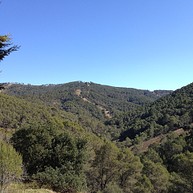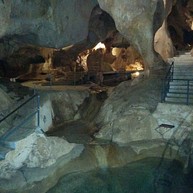
-
![Malaga park]() Provided by: trabantos/Shutterstock.com
Provided by: trabantos/Shutterstock.com

Our travel guides are free to read and explore online. If you want to get your own copy, the full travel guide for this destination is available to you offline* to bring along anywhere or print for your trip.
*this will be downloaded as a PDF.Price
€4,95
Malaga Park
The guide was updated:Malaga Park is a sprawling 33-hectare urban oasis, boasting a blend of botanical gardens, fountains, and sculptures. This picturesque city green space offers a serene escape from the bustling streets of Malaga, providing visitors with a tranquil ambience to unwind and appreciate the beauty of nature amidst artful creations.
Useful Information
- Address: Paseo del Parque, 1, Malaga
- Opening hours: 24/7
Digital Travel Guide Download
Our travel guides are free to read and explore online. If you want to get your own copy, the full travel guide for this destination is available to you offline* to bring along anywhere or print for your trip.
*this will be downloaded as a PDF.Price
€4,95

Housed in the Palacio de Buenavista, a historic 16th-century building, the Picasso Museum boasts an impressive collection of over 250 artworks donated by members of Picasso's family. Visitors can explore the diverse range of pieces, including paintings, drawings, sculptures, and ceramics, spanning various periods of the artist's career. Just a stone’s throw away at Plaza de la Merced the house where Picasso was born is also open to the public.
Read more

Alcazaba
The Alcazaba is a palatial fortification, which stands as a testament to Malaga’s rich Moorish past. Built in the 11th century, the fortress features an intricate network of fortified walls, elegant courtyards, and beautifully landscaped gardens. Perched on a hill, the Alcazaba offers breathtaking panoramic views of the city and the Mediterranean Sea.
Read more

Port of Malaga
The Port of Malaga is a bustling and dynamic port that serves as a gateway to the Mediterranean. With a rich history dating back centuries, the port has played a crucial role in the city's economic and cultural development. Today, it is a vibrant hub for trade and tourism, welcoming cruise ships, cargo vessels, and yachts from around the world. Its beautiful waterfront is lined with cafés, restaurants, and shops, making it the perfect place for a stroll and a nice lunch in the sun.
Read more

Malaga's Beaches
Stretching along the Promenade of Pablo Ruiz Picasso, Malaga boasts kilometers of stunning sandy beaches, flanked by an array of charming restaurants and bars. Among the city's most beloved beach destinations are La Malagueta and La Caleta. These two picturesque beaches offer a range of convenient facilities, including showers, toilets, sunbeds, and more, ensuring a delightful and comfortable beach experience for visitors.
Read more

Centre Pompidou Malaga
Fans of the postmodern won't want to miss Centre Pompidou Malaga, the only branch of the iconic gallery outside of France. Housed in 'El Cubo,' a giant glass cube in Malaga's Port, the centre houses seven sections: metamorphoses, the body in pieces, the political body, self-portraits, man without a face, the workshop of Brancusi, and one dedicated to the architecture of the first Pompidou Centre in Paris. It is also home to the masterpiece 'The Frame' by Frida Kahlo.
Read more

Iglesia de los Santos Mártires Ciriaco y Paula
If you enjoy the history and splendour of old churches, Iglesia de los Santos Mártires Ciriaco y Paula will certainly impress you. Built in the 15th century in Gothic style, the church's exterior boasts intricate detailing and a majestic bell tower, while the interior features beautiful stained glass windows and ornate altars.
Read more

Feria de Agosto
Feria de Agosto or Feria de Málaga is a vibrant and exuberant festival, which takes place every August in the city of Malaga. This week-long celebration embodies the rich cultural heritage of the Andalusian region and features lively street parades, flamenco performances, and traditional music. Colourful casetas (tents) line the streets, offering delicious local cuisine and drinks. Families, locals, and tourists come together to revel in the joyous atmosphere, creating unforgettable memories amidst the enchanting backdrop of Malaga's historic landmarks.
Read more

Playa de las Acacias
Nestled between two prominent cliffs, Playa de las Acacias is a quiet beach great for sunbathing, swimming, and leisurely strolls along the shore.
Read more

El Caminito del Rey Hike
El Caminito del Rey begins an hour's drive away from the city of Malaga, running from north to south. The hike takes you through gorges, canyons and past a beautiful suspension bridge. The entire route is 8km long and takes between 3-4 hours to complete. Adventurers will be rewarded with stunning views of the Andalusian landscape.
Read more

Wine Museum
Wine enthusiasts won't want to miss Museo del Vino. Take a tour to learn all about Malaga's wines, as well as the industry's history and cultural significance.
Read more

Montes de Malaga Natural Park
Named after the Montes de Malaga range located just 5km from the city of Malaga, this natural park defining features include rugged massifs and steep slopes, creating a stunning landscape. Visitors can enjoy the beauty of the magnificent pine forest, which provides a habitat for numerous birds of prey. The park also boasts a diverse array of flora, inviting exploration along its marked trails. Additionally, visitors can delve into the area's cultural heritage through the ethnographic museum situated within the park.
Read more

Cueva del Tesoro
One of only three marine caves in the world, Cueva del Tesoro is home to unique geomorphic formations. First settled in the Palaeolithic Age, the caves are filled with cave paintings. Legend has it there is also a lost, ancient treasure ('Tesoro') hidden somewhere in these crevices!
Read more

Museum of Glass & Crystal
Housed within a restored 18th-century mansion, the Museum of Glass and Crystal showcases a private collection of decorative glass spanning various historical eras across two floors, each accompanied by period furniture.
Read more

Hammam Al Ándalus — Arab Baths
Experience the timeless Andalusian tradition of the Arab bath at Hammam Al Ándalus, where blissful hot and cold baths await, complemented by soothing massages. Surrounded by elegant arabesque architecture, immerse yourself in a tranquil ambiance that allows for a reconnection with yourself and a moment of utter relaxation.
Read more

Colección del Museo Ruso
Nestled within this cultural outpost lies a unique and remarkable collection of art sourced from the Leningrad State Museum. Here, visitors can delve into the very essence of Russia's cultural soul, spanning from the grandeur of palatial art to the creativity of postmodern expressions. Alongside the permanent and rotating exhibitions, the experience is enriched by readings, lectures, and performances of classical music and folklore, offering a comprehensive and immersive understanding of various facets of Russian art.
Read more

Malaga Cathedral
The Cathedral of Malaga was built between 1500 and 1700 on the grounds formerly occupied by the Aljama Mosque. Its architectural style is predominantly Renaissance, adorned with a Baroque main façade and decorative elements.
Read more

Botanical Garden
The affluent couple Jorge Loring and Amalia Heredia created this beautiful garden around their hacienda La Concepción in the 19th century. Here you can find 30.000 square meters filled with 500 tropical plants — the garden is one of the few gardens with subtropical plants in Europe.
Read more

Contemporary Art Centre of Malaga (CAC)
The Contemporary Art Centre of Malaga's primary focus is to promote and showcase 20th- and 21st-century visual art by international and emerging Spanish artists. Its permanent collection, consisting of over 400 exhibits, represents a diverse range of artistic disciplines, including late 19th-century Impressionism to various trends in 20th-century art. From painting and sculpture to photography and video creations, the CAC Malaga presents an interesting and expressive mix of artistic languages.
Read more

Roman Theatre
Situated at the foot of the Alcazaba fortress, El Teatro Romano (Roman Theatre) is the oldest monument in Malaga. This ancient theatre, constructed in the first century BC during Emperor Augustus's reign, remained in use until the third century AD. Subsequently, it fell into disrepair for centuries until the Moors settled in the region, using it as a quarry to build the Alcazaba fortress. Over time, it became buried under debris and remained hidden for nearly five centuries. In 1951, the first archaeological traces were uncovered during the construction of Casa de Cultura, leading to its rediscovery.
Read more

Malaga Park
Malaga Park is a sprawling 33-hectare urban oasis, boasting a blend of botanical gardens, fountains, and sculptures. This picturesque city green space offers a serene escape from the bustling streets of Malaga, providing visitors with a tranquil ambience to unwind and appreciate the beauty of nature amidst artful creations.
Read more

Plaza de la Marina
Plaza de la Marina, situated in the heart of Malaga's modern district, is one of the city's most distinctive landmarks. The square is adorned with elegant buildings, a playful water fountain, and a handful of palm trees.
Read more

Bike Tours
Experience the best of Malaga on two wheels and discover its hidden gems at your own pace by renting a bike either with your transportation card or opting for long-term bicycle rentals provided by various firms. Pedal your way through its ancient alleys, feel the wind in your hair as you explore the captivating Promenade of Pablo Ruiz Picasso, and soak up the sun on the stunning Malaga beaches.
Read more


